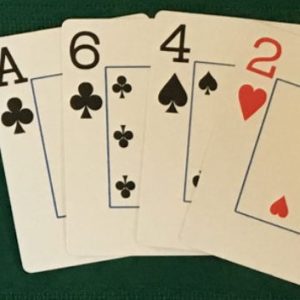Playing Low Cards in PL Omaha

Pot-Limit Omaha is customarily known as a game where big cards are the king of the ring. However, there are spots where playing small cards can prove profitable as well.
Today, we will take a look at playing hands with low cards. These weaker hand can be played profitably provided you have a good read on the situation.
Hands Containing Low Pairs
There are many players that will look at a hand with a low pair and think that the hand has a good chance to hit a full house. While that may be true, it is a very deceptive hand to start with.
Let’s say you get something like 3-3-6-7. You have a pair of threes. Let’s assume a three hits the flop. Yes, you have just hit a set, but how good is your set really? Was there any action pre-flop? What are the overcards on the board? Are there any draws?
The bad thing with low pairs is that even when they make their full house, it is vulnerable. Let’s say the board is 3-10-8-8-J. How strongly do you feel about your full house now? It is very feasible that someone has 10-8 or J-8. As such, your hand is toast. Even 8-3 beats you here.
If you are going to play low pairs, you will be vulnerable and need to play your full house cautiously to any significant action.
Some people will fall into a trap of overplaying a low set against a drawing board. This is a spot where you are going to want to consider laying down your set. Let’s say you have the two threes but the board is 3-10-9-8-J. How likely is your set to win in this spot?
Low Wraps and Flush Draws
Low wraps and flush draws are among the trickiest low hands to play in PLO. When I refer to a low wrap or flush draw, I am referring to any four cards that are below eight. These cards will customarily form the sucker end of many straights, and when the flush hits, it is very vulnerable.
The main exception to this rule is a hand including a suited ace. When you have four low cards with a suited ace, you have a shot at the nut flush. While you shouldn’t play this like you have a big wrap, you do have a bit more equity to see the flop. Otherwise, when you are playing these types of hands, you want a board staying low.
For example, if you have a hand like 5d-6s-7d-8c, you want a flop like 2-3-7. This effectively handcuffs the high hands and gives you the best chance to have a nut draw.
When playing low suited cards and your low flush hits, you need to play it a bit cautiously. In our example, a seven-high flush is super vulnerable.
Flop Texture is Important
When playing low hands, flop texture is very important. You want the flop to stay low to middling at worst. Flop texture will quickly allow you to determine whether to continue with many of these hands.
The key to playing these hands is to avoid confrontations that see you with the sucker end of a straight or full house or holding an inferior flush. You also want to avoid getting all of your money into a pot where there are a ton of draws against you.
For example, if you have 5d-6s-7d-8c and the flop is 9d-7c-Kc, you want to avoid getting all of your money in on a draw. This is because you are likely drawing to the sucker end of a straight and possibly facing a flush draw.
Caution and flop texture is the name of the game when playing low cards in PLO. They can be played profitably. Omaha Hi-Lo is a much better game for low cards, but don’t overlook them in PLO.
